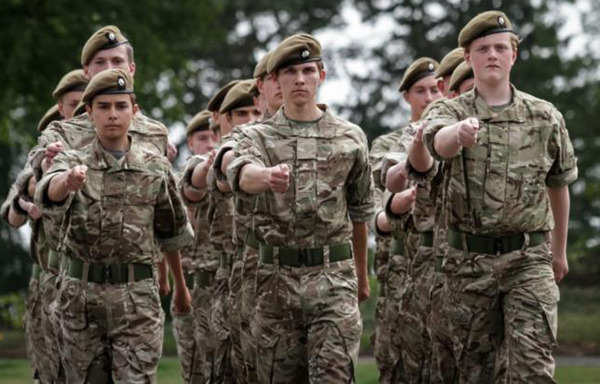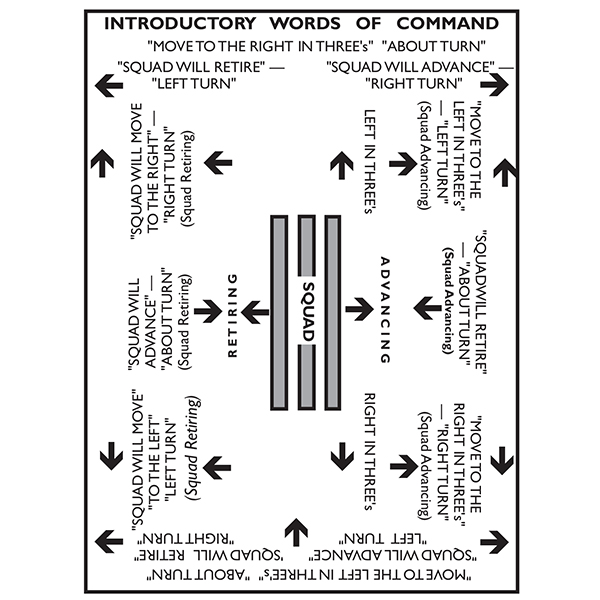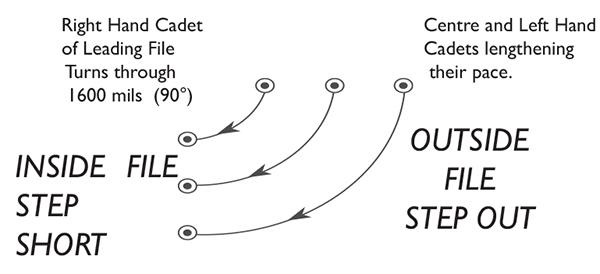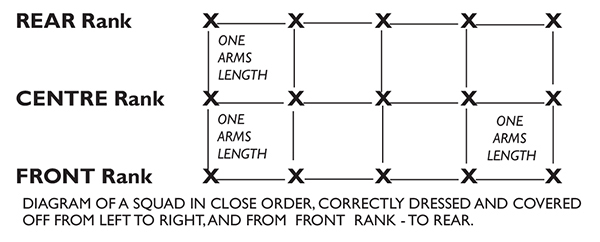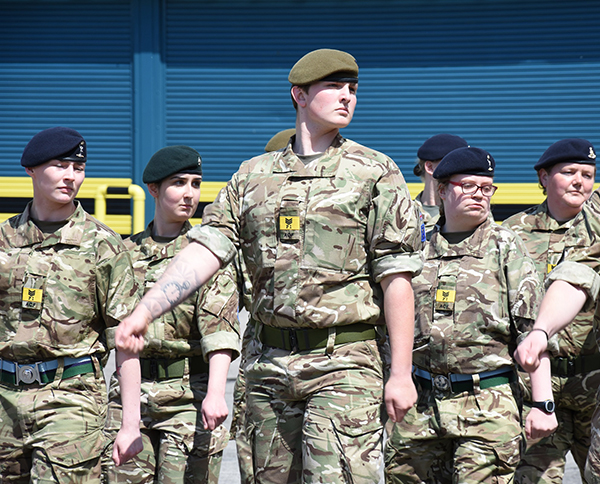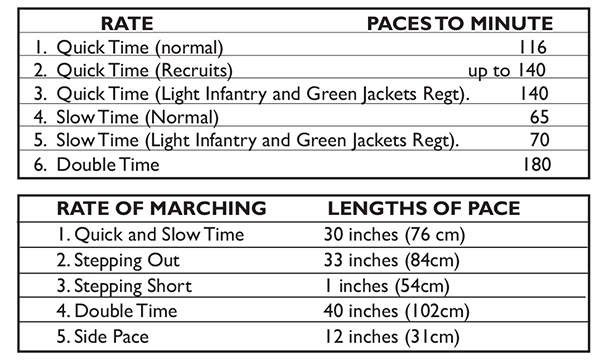Drill Within the ACF and CCF
THE HISTORY BEHIND DRILL
Drill is the term used to describe a formal parade where you are able to move quickly in formation from one place to another.
Through history, British Army Drill has been the foundation upon which discipline; teamwork, pride and pageant have all taken equal part.
In the days of the ‘Brown Bess’ musket, when in battle, the infantry formed a square in their three ranks in order to give effective firepower.
This action was carried out as a drill, taught and practiced on the barrack square. The discipline required to ‘hold the line’ was the difference between defeat and victory. Drill parades were hard and rigorous, with harsh violence dished out by the instructors. Times have changed, but the British Army still rely on drill to build team spirit and to train the soldiers’ mind to respond to orders given in the quickest possible time.
INITIAL DRILL LESSONS
When you are first introduced to Drill Commands, you may find that your reactions are slow and mistakes easily made. Fortunately your initial lessons are all completed at the ‘Halt’ i.e. stood still. Once you have mastered the initial movements and been taught how to march without your arms moving in the wrong order, you will suddenly find it all comes together, your squad starts to move as a team.
It will probably feel even better when you take part in a Civic or Cadet Sunday Parade. You will be with the rest of your Detachment, smartly turned out and marching behind a band. It might sound odd to those of you who have not attended such Parades, but it gives you a real ‘Buzz’ and dare it be said, pride in your Detachment and the Army Cadet Force. (Particularly if your family and friends are watching!)
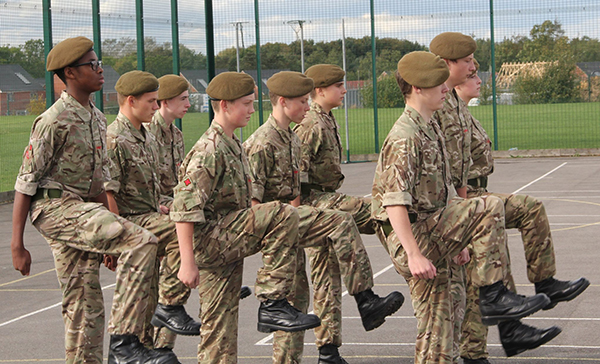 Brooke Weston CCF Beret Parade - September 2016
Brooke Weston CCF Beret Parade - September 2016
DRILL – INTRODUCTORY WORDS OF COMMAND
Used for Squad Drill Good instructors give INTRODUCTORY words of command giving warning of what the next word of command is to be. Many instructors do not do this; the result is the squad turning in different directions at the same time!
Before moving a squad in any direction, the instructor indicates what direction they intend to move them by using an INTRODUCTORY word of command, before giving the actual command to execute the order. As a member of the squad, this does give you the time to work out the direction of your next move.
Look at the diagram above. Look at it sideways as if you were standing in the center of the front rank of the ‘squad’, facing the same direction as the arrow pointing to ‘ADVANCING’.
The words of command you should be given to move the squad in any particular direction are as shown in the diagram. There is a table below which also shows on what foot the executive word of command is given.
CHANGING DIRECTION - WHEELING ON THE MARCH
The term "Step Short" means reduce the length of your pace, "Step out" means slightly lengthen your pace. By doing this while Wheeling you keep your Dressing in each file as it changes direction.
A common fault when giving the "Left or Right Wheel" is for the command to be given sharply, when in fact it should be drawn out - "WHEE-EEL", allowing the files to slowly change direction, keeping their dressing in three's. You must glance out of the corner of your eyes to check your dressing, not turn your head.
MARCHING & DRESSING OFF
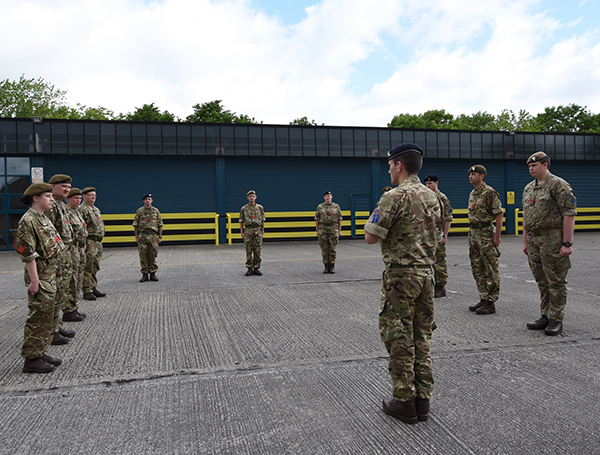 Adult Instructors Basic Induction Course at Fox Barracks, Chester.
Adult Instructors Basic Induction Course at Fox Barracks, Chester.
TEACHING DRILL
The aims of Drill are:
1. To produce a Cadet who has self respect, is alert and obedient
2. To provide the basis for teamwork.
Drill is exacting and strict attention to detail must be observed. You will need the following qualities to become an excellent Drill Instructor.
PATIENCE. Never lose your temper.
ENTHUSIASM. You must fire your squad with a will to achieve.
CONSISTENCY. Set yourself and the squad a high standard and do not deviate from it.
HUMANITY. Understand the squad’s problems; praise readily, do not become over familiar or humiliate individual members ofyour squad.
PERSONALITY. As a drill instructor you must impress your squad – always have them under control, lead by example:
When demonstrating, be accurate; never exaggerate a drill movement. If the movement is with a rifle use that article and nothing else.
Never use bad language and sarcasm; it is the sign of a poor instructor. Ensure that your words of command are clear, DO NOT create your own ‘drill language’, it is bad practice.
THE WORDS OF COMMAND
All words of command must be clear and powerful; the way in which they are given affects the reaction that they inspire. Words of command are divided into three parts:
INTRODUCTORY. This tells the squad what movement they are about to carry out, e.g. “MOVE TO THE RIGHT IN THREES”.
CAUTIONARY. The drawn out and loud reminder to the squad, e.g. R –I – G – H – T.
EXECUTIVE. The high-pitched sharp command “TURN”.
Sometimes there is no need for an INTRODUCTORY word of command.
The cautionary word of command should be consistently drawn out over about the equivalent of Four paces in quick time. There should be a pause between it and the executive word of command.
There should be a pause between it and the executive word of command of:
1. At the Halt – the regulation pause.
2. In Quick Time – about four paces
3. In Slow Time – about three paces.
DEVELOP YOUR WORD OF COMMAND
The following information will help you develop good voice control. Practice whenever you can.
Explanation
Many drill instructors end up with sore throats after a prolonged drill practice. This may well be because they do not use their lungs correctly. It is important to breathe in through your nose and take your breath ‘right down to your stomach’. In other words, learn to breathe deeply. When giving a word of command, ‘push’ the air out. Do not forget to stand to attention when giving commands. Standing with your feet apart or leaning backwards may result in straining your groin. KEEP YOUR WEIGHT FORWARD AND YOUR FEET TOGETHER.
Have your head up, looking directly at your squad; when giving the word of command AIM your voice straight over the squad.
Giving Words of Command
Giving a Cautionary or preliminary word of Command you have to pitch your voice on the same note to ensure that it does not ‘tail away’ at the end. It must be short and sharp, “SQD”. Then comes the Executive word of command, equally short and sharp, “SHUN”.
It is most important to develop the correct method of delivering commands; nothing is worse than a poor drill instructor. If you really cannot do it properly, leave it to someone who can.
Words of Command
They must be pronounced CLEARLY. It is not just a sound. A quick tightening of the stomach muscles so that the word comes out quick, short and higher in pitch than the Cautionary produces the Executive word of command. Ensure that there is a pause between the Cautionary and the Executive. Failure to do this may result in the squad anticipating the word of command, thus the whole purpose of drill is lost – and chaos will reign!
Note: Use your mouth; the wider open it is, the louder the sound!
To summarise:
Power: plenty of air into the lungs.
Pitch: Hold your head high and pitch the word of command high over the Squad.
Punch: Given quickly by tightening the stomach muscles.
Pronunciation: Make your words CLEAR. LOUD and AS AN ORDER.
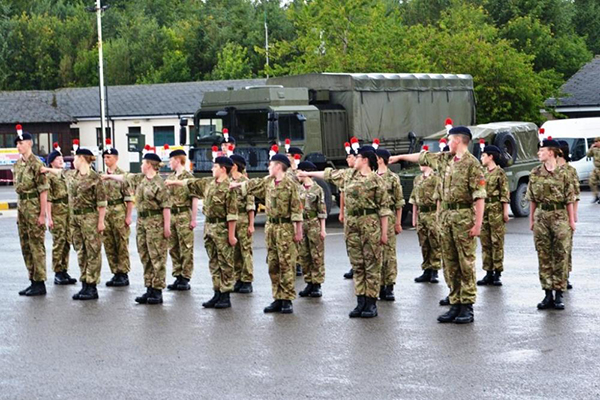 1 (Minden) Company Drill Team, Annual Camp 2015
1 (Minden) Company Drill Team, Annual Camp 2015
COMMUNICATION DRILL
First demonstrate to the squad all words of command at the halt, including rifle drill.
1.Then “conduct” the squad while they give elementary words of command; insisting on clarity and power from each cadet.
2. Divide the squad in to two ranks, place them about 25 metres apart, with 5 paces interval between each cadet.
3. Each cadet should now drill his/her opposite number 25 metres away without regard to those to the left or right of them.
4. After no more than ten minutes, change the ranks, so that the cadets in both ranks have a chance of controlling their opposite number.
MUTUAL DRILL
Form the squad into three ranks and explain the introductory word of command and which is the DIRECTING FLANK.
Call out each member of the squad in turn to drill the squad and then call out another member of the squad to watch and be prepared to comment on his/her performance.
Note:
1. Be patient and make encouraging comments.
2. When correcting, be sure you address your remarks to the whole squad, they can all learn by one cadet’s mistakes.
AIDS TO BETTER DRILL
Calling out the time
All cadets in their early stages of training should call out the time of their Drill movements so that:
- Every member of the squad has the regulation pause fixed in their head.
- The squad learns to act together, building team spirit.
- The squad should call out the words for a given movement.
- They must learn to be still when calling out “TWO THREE” for the regulation pause.
When you can see your cadets improving, select individuals to call out the time for the whole squad. It helps to build the confidence of the more junior cadets.
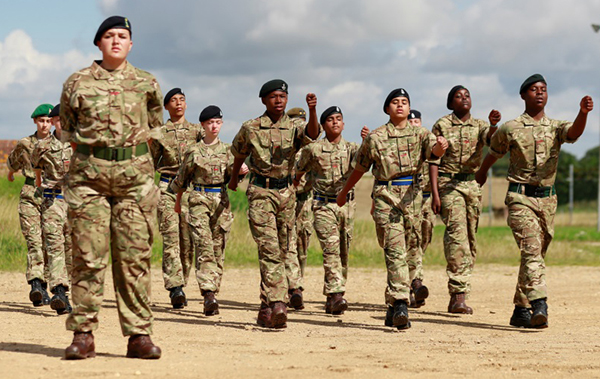 ACF Rollestone Camp - Rollestone - Images/Jason Cairnduff
ACF Rollestone Camp - Rollestone - Images/Jason Cairnduff
Timing and Pace
All Instructors should know the rates of marching, measured in the number of paces taken in a minute, the length of the pace being taken, measured in inches/mm and the timings of both foot and arms drill. The recognised measurements are set out below. However, it must be remembered that these are for grown adults NOT Cadets, therefore some allowance must be made as and when required.
Rates Of Marching
DEFINITIONS
Alignment – A straight line on which a body of Cadets is formed or is to form.
Covering - The act of placing yourself directly behind another body.
Depth - The space occupied by a body of Cadets from front to rear.
Distance - The space between Cadets or bodies from front to rear.
Dressing - The act of aligning oneself with and covering others within a body of Cadets.
File - (a) Either two or three Cadets of different ranks who are covering each other, or (b) A body of Cadets in two ranks facing a Flank.
Single File – Cadets one behind another on a frontage of one at normal marching distance.
Blank File - A file in which there is no center and rear Cadet, or no centre Cadet, due to the inequality of numbers within a body of Cadets.
Flank – Either side of a body of Cadets as opposed to its front or rear.
Directing Flank - The flank by which a body of Cadets takes its dressing.
Frontage - The extent of ground covered laterally by a body of Cadets, measured from flank to flank.
Interval – The lateral space measured between Cadets or bodies of Cadets on the same alignment.
Line – Cadets formed in the same alignment.
Markers – Cadets employed to mark points on which a movement is to be directed, or by which a formation or alignment is to be regulated.
Order (Close or Open) - The distance between ranks in line, which is either thirty inches or sixty inches depending on circumstances.
Rank – A line of Cadets side by side. (i.e. ‘Front Rank’).
Supernumerary Rank – the extra rank, fourth rank in three ranks, or third in two ranks, formed by the senior NCOs of a body of Cadets.
A Squad – Means a sub – unit formed for Drill and is used throughout to avoid explanations.
A Regulation Pause. Refers to the short pause between two movements of drill, which is the equivalent of two marching paces in quick time, i.e. Forty movements to the minute.
SOME GUIDING PRINCIPALS FOR PARADES
A parade should always start with an inspection of all who are on it.
Strict observance of rank should be shown; therefore an Officer, Adult Instructor or a Cadet, when they wish to either join or leave the parade, should report to the senior rank and ask permission to do so.
Cadets should not walk across a parade ground when drill, in which they are not taking part, is taking place.
Those who are to command it should plan the form and purpose of a parade beforehand and ensure all participants are made aware of it.
At the end of a parade all ranks “Dismiss” to show respect to the senior rank present.
Having been dismissed from a parade, march smartly off the parade ground without stopping for a “Chat”.
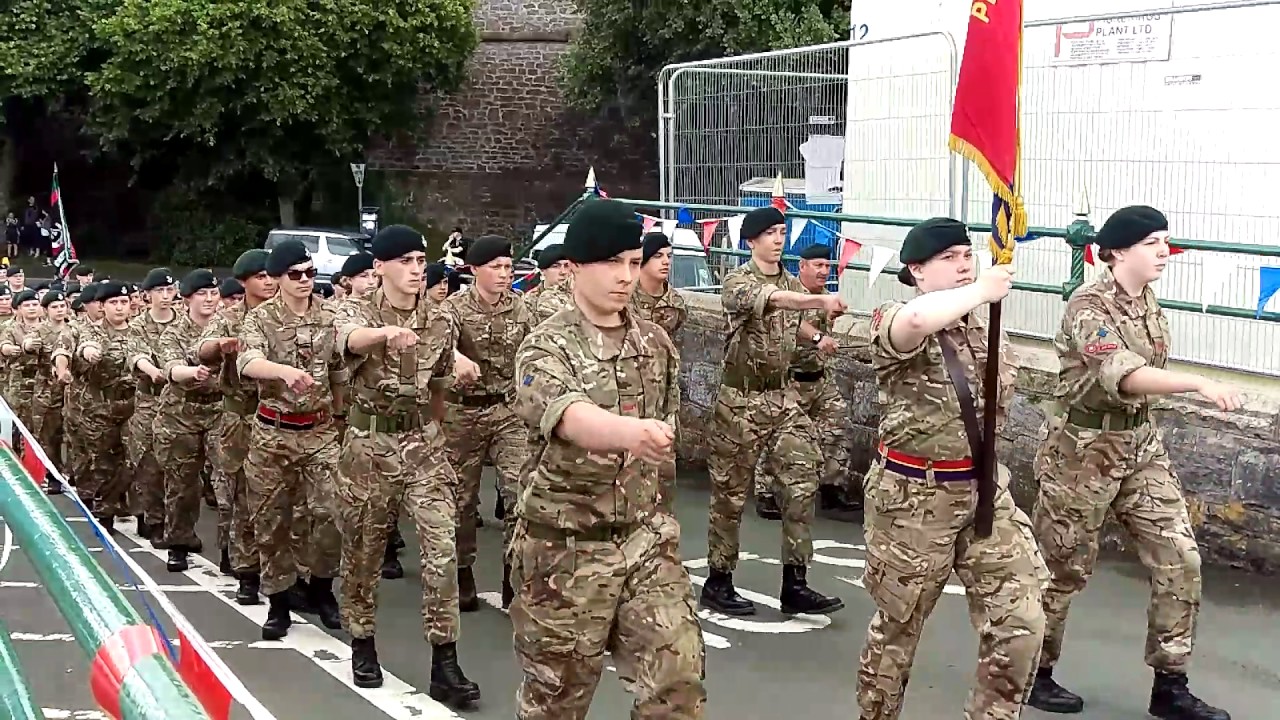 Devon ACF at Plymouth Armed Forces Day
Devon ACF at Plymouth Armed Forces Day

